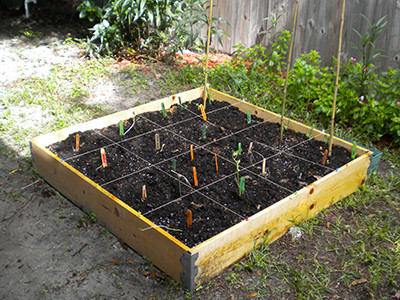Square Foot Gardening
There are so many ways to grow edible plants in your landscape. Many people are familiar with traditional rows of edible plants; square-foot gardening offers something a little different.

Square-foot gardening allows you to make your vegetable garden efficient and more of a landscape feature. Many gardeners may be hesitant to dig up their front yard and plant rows of veggies, but adding a planting box or two to your landscape can be both productive and lovely.
For square-foot gardening, you build a raised box and divide the planting area into squares. You use completely new soil in this planting box, an advantage for gardeners trying to grow in Florida’s sandy soils.
The smaller footprint of square-foot gardening makes it an ideal choice for beginners, those with smaller landscapes, and gardeners who might find bending down to ground level difficult.
Construction
Generally square foot gardens are created in a 4′ x 4′ planting area. A 4′ x 4′ planting box is great because it gives you a decent sized area to grow in, without being so large that it’s difficult to reach the middle from the sides. Remember, you never want to step into your planting area, so you want to be able to reach into the center in order to weed, plant, and harvest.
You don’t have to limit yourself to just one planting box either, just be sure to leave yourself aisles that are large enough to work in. Aisles that are three feet wide are generally considered to be a good width.
The techniques for building a square foot garden bed are similar to those for building a raised bed. Wood is the most popular building choice, although some gardeners do use bricks, stones, concrete blocks, or synthetic materials. When choosing wood remember that untreated lumber will start to rot within a year. Look for ACQ-treated lumber approved for “Ground Contact,” which is approved by the FDA for food production. Take extra care if you are thinking of using old wood; lumber purchased before 2004 was usually treated with creosote and arsenic, and could contaminate your food. When choosing screws, stainless steel is the best choice when using ACQ-treated lumber.
While some gardeners make a reusable or even permanent grid to divide up their planting area, you can simply make a temporary grid using whatever you have readily accessible. Sticks, string, twine, or even strips of wood work well and are generally easy to come by. If you are interested in making a reusable grid, UF/IFAS Orange County Extension has a great tutorial (PDF).
After creating your grid, lay it on top of the soil in your planting box to guide you in sowing seeds. If you are working in a 4′ x 4′ planting area, you should end up with sixteen 1′ x 1′ squares. If working in 16 squares is a little intimidating, you can always start with a smaller planting area; for example, 3′ x 3′ area would give you only nine squares to plant in. Of course, you’re not limited to squares; you can make a rectangular planting area instead.
Filling your planting box
By building a planting box above ground and filling it with new soil, you give your plants a great start. You should either fill your box completely with blended compost, or you can use a mixture of equal parts coarse vermiculite, peat moss, and blended compost.
With square-foot gardening, plants are placed close together in order to increase the vegetable yield per square foot. This can also help with weed control since the closely growing plants will create a shady canopy, making it more difficult for weeds to take over your vegetable bed.
You’ll plant either one, four, nine, or sixteen plants per square. Exactly how many depends on what you are planting. For plants that take up more space you will want to plant only one per square; this includes sweet and white potatoes, broccoli, kale, collards, cabbage, tomatoes, eggplants, cucumbers, okra, and peppers. Slightly smaller leafy plants like lettuce, chard, spinach, bok choy, and many herbs can be planted four per square. Beets, turnips, string beans, or peas can be planted in groups of nine per square foot. And for those plants that take up very little space, like carrots, radishes, and onions, you can fit sixteen plants in one square foot.
Adding a trellis for climbing plants adds even more efficiency to your garden; plant two cucumbers or other climbing vegetable per square. When building your trellis, be sure to place it on the outer edge on the north side of your planting bed so that it doesn’t shade the rest of the garden plants.
When planting, have variety in your planting box; don’t fill all sixteen squares with the same plant. As you harvest, continue to change out plants. For a little extra color and interest, you could even add some flowering annuals.
One of the benefits of square-foot gardening is ease of maintenance. Since the planting area is relatively small, many gardeners are able to adequately water by hand. The best time to water your plants is in the morning, avoiding rapid evaporation while also preventing some diseases. Be sure to always tend to your garden from the aisles. You never want to walk on the soil in your growing box; this compacts the soil and can hurt plant roots.
Since you will be planting different crops together you may find yourself in a continuous and fulfilling cycle of harvesting and planting. As you harvest one square in your garden, add compost to the square and plant a different crop.
Square-foot gardening is just one way you can start a vegetable garden in your landscape. Many gardeners find vegetable gardening to be a relaxing activity, and there is nothing like the satisfaction of eating something that you grew in your own backyard.
